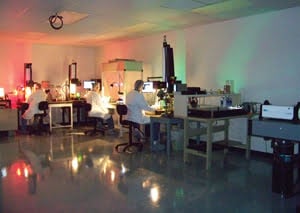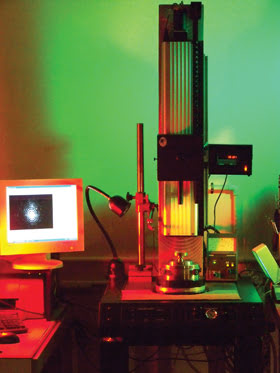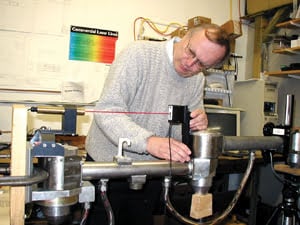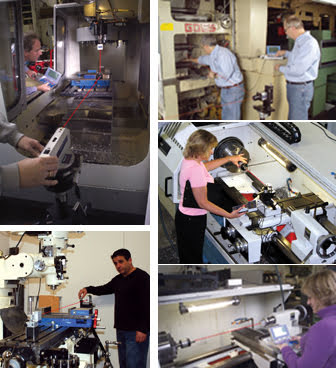Laser alignment affords manufacturers great
precision and efficiency in assessment of their equipment, allowing them to take
minute measurements and correct tiny errors that otherwise could mean big problems
down the line, including materials wasted or time lost.
To get a picture of current activity in laser alignment, Photonics
Spectra turned to experts from two companies in the thick of things: Opto-Alignment
Technology Inc. in Indian Trail, N.C., and Pinpoint Laser Systems Inc. in Peabody,
Mass.

Opto-Alignment assembly cleanroom with alignment stations. Courtesy of Opto-Alignment.
Steve Bohuczky is the executive director of business development
for Opto-Alignment Technology, also known as OAT. Opto-Alignment produces alignment
and assembly equipment for ultraprecision and precision optical systems. It “specializes
in narrow confocal laser reflection-based measurements of lens centration and lens
tilt to submicron level,” Bohuczky said. One new OAT product is the Laser
Alignment Station (LAS), which enables measurement and correction of even “a
tiny 2-arc-second tilt.” Additional modules also allow it to measure lens
thickness and air space in lens systems.

One of Opto-Alignment’s newer products is the Laser Alignment Station. Courtesy of
Opto-Alignment.
Mory Creighton is the general manager at Pinpoint Laser Systems.
Pinpoint provides laser measuring and machinery alignment equipment for manufacturing.
The company is introducing two laser receivers based on customer feedback, the 4D
Microgage and the Microgage 2D Transparent. These will allow precision measurements
on machine tools and assembly equipment.
Q: What do you see as the “next big thing” in laser
alignment in general? Are you seeing any new and exciting laser alignment advances
coming out of R&D and/or university labs?
Creighton: Fixturing, software and manufacturers taking on their
own alignment.
As machinery configurations change, the fixturing for alignment
systems and techniques needs to change as well. Rails and slides become longer,
CNC [computer numerical control] machine tools have different work enclosures driven
by safety, and working considerations and alignment fixturing has to adapt to these
changing needs. Many of our customers come to us looking for adapters and new fixtures
for their alignment systems as they take on new tasks that they were not considering
two or three years ago but that have become important now.

Checking the angular orientation and deflection of the arm on an
inspection robot. Courtesy of Pinpoint Laser Systems.
Software – what do the measuring and alignment numbers mean
and how do they relate to corrective action taken on the production line? Software
that allows people to quickly see the alignment condition of their production machinery
is a great asset in reducing their downtime and producing better finished products.
We see a steady trend in manufacturers bringing their alignment
capabilities inside their organization. Companies need to remain competitive in
the global environment – thinner materials, faster throughput and more complex
manufacturing processes require precise machinery operation. For years, there has
been a strong reliance on outside, third-party alignment vendors, and these services
have become very costly, and often there are long waiting periods in scheduling,
which has a significant manufacturing impact on machinery downtime, rising production
costs and scheduling.
Our observations show that production workers and plant engineers
are very familiar with their own production equipment and – given a good,
precise measuring and alignment tool – they do a much better job in maintaining
alignment on their production equipment, reducing downtime and ultimately improving
their own manufacturing profits.
The development of new laser technology, detectors and optics
moves steadily along in both industrial R&D as well as government and university research
settings. Pinpoint is actively involved with this process as well and regularly
introducing new products such as the Microgage 4 Axis Receiver and the 2D Transparent
Receiver – both unique products driven by requests from our large customer
base. Methods to apply alignment data and findings to automated equipment is a growing
area, particularly as CNC machinery runs faster and faster under automated control,
and manufacturing tolerances become tighter.
Bohuczky: There are too many R&D projects out there with very
promising results. I read about around-the-corner 3-D imaging of objects that are
out of the straight line of sight, by measuring the time of multiple reflections,
almost like laser echo. OAT is preparing to build mid- and long-IR LAS devices as
soon as a specific need and budget are there.
Q: Which application areas would you say are currently thriving
– and why?
Creighton: We see a lot of growth and business activity in the
continuous process side of the manufacturing industry. For example, paper mills,
converting lines, steel and metal production, electronic component manufacturing
and others cannot afford unexpected downtime. Competition is tight, and profit margins
are small and, consequently, manufacturing planning and maintenance need to be right
on track. We are seeing a lot of customer needs in this area now, particularly for
equipment that supports preventive maintenance.

Laser alignment offers a quick, efficient way for manufacturing companies to run preventive
maintenance checks and make sure that equipment is properly set up. Courtesy of
Pinpoint Laser Systems.
New technology manufacturing is also a driving force in our industry.
Helicopters, aircraft, ships and automobiles are made out of new materials, such
as advanced composites that influence the manufacturing and assembly process. In
the past, large dedicated tooling was created for single product fabrication and
assembly. Over the past five to 10 years, the move has been toward flexible tooling,
and measuring and alignment equipment that can adapt to many different products
being produced. We see strong growth potential for companies that can work in this
arena.
Bohuczky: I noticed that there is a fast growing arsenal of medical
laser instruments on the market, and I think more will be widely available to the
noncash patient base soon. Obviously, the aging population in the Western world
is a major driver. Some of the scientific applications are a little harder to pinpoint,
partly because there are too many.
As far as military applications, I hope that the global powers
will or already have agreed not to integrate laser-based small arms into their military
arsenals. Eventually, these would become available to anyone and establish an “invisible,
undetectable” threat.
Q: How would you say the market has been in the past few years for
laser alignment?
Bohuczky: Laser alignment and measurement is now in every corner
of technology and industry. The expansion was fast and logical, and it will continue.
Creighton: The economic climate over the past couple of years
has been challenging, particularly for manufacturing industries. Reductions in production
activity, cost-cutting measures and turnover in the workforce have influenced the
market for all machinery alignment, including laser alignment equipment.
However, we have recently seen a significant increase in manufacturing
activity in certain industrial sectors and an aggressive approach to bringing machinery
back on line and performing the needed alignments to keep this equipment running
smoothly and efficiently. Our business activity is increasing steadily, and we hope
that this progress will continue.
Q: Where do you think the market for laser alignment is going?
Bohuczky: Measuring the presence and distance of objects relating
to safety in industry and everyday life will be one of the most important new markets.
Creighton: One trend, mentioned earlier, is the movement toward
companies taking care of their own machinery and equipment alignment. A lot of customers
are replacing traditional methods with laser alignment products. This is often seen
now as a necessity rather than a luxury. The measuring and alignment products available
today have become so easy to learn and use that manufacturing companies are equipping
their workforce with these tools. Their motivation is to reduce outside alignment
costs and delays and to better tap into the knowledge and expertise of their own
workforce.
Stronger focus on preventive maintenance is pulling the laser
alignment market in new directions. Manufacturing is embracing preventive maintenance
with new techniques, data and scheduling tools, and other resources in an effort
to improve profitability. Here at Pinpoint, we have seen a stronger focus on manufacturers
using precision equipment to take quick snapshots of their machinery alignment and
condition monitoring for more organized equipment maintenance and improvements.
Tight manufacturing schedules, JIT [just in time] production and growing foreign
competition leave little room for unexpected production downtime events.
A slow and steady movement away from optical alignment scopes
toward laser equipment that is easier to use, more precise and repeatable from user
to user. As seasoned manufacturing people leave the workforce, the knowledge base
for using optical alignment equipment is leaving with them. Employees, more than
ever, move from job to job, and the laser alignment equipment available on the market
today is easier and faster to learn, while at the same time it improves the speed
and precision for routine and complex machinery alignment.
Q: What are the biggest challenges to new advances in laser alignment?
Bohuczky: One of the challenges is increasing sensor resolution
to increase measurement accuracy.
Creighton: The growing variety of manufacturing needs and production
systems poses a challenge for manufacturers of machinery alignment equipment. Customers
want turnkey products that are right out of the case, ready to go on their specific
production equipment. Alignment needs for manufacturing companies are becoming more
demanding and diverse. Companies that sell “standard” alignment products
and are unwilling to deviate from their particular product offerings are facing
pressure from their customers for new alignment needs and opportunities. We have
had strong success over the years working with individual customers, understanding
their particular needs and adapting products to meet these needs and requirements.
Workforce turnover and short-term thinking. As employees change
their jobs and roles within industry, manufacturing companies often feel the pressure
of losing manufacturing continuity and their long-term perspective. New people are
trying to learn new jobs, and while on this learning curve, it is easy to lose sight
of long-term objectives and planning. We sometimes see that, when this long-term
planning and viewpoint are set aside, production efficiency suffers through more
downtime events and slower recovery from addressing unexpected problems. The adage
“Rome was not built in a day” holds very true for manufacturing knowledge
and technology.
The complexity of an efficient and profitable manufacturing operation
can make it difficult to change people, processes, techniques and equipment on a
rapid basis and still remain efficient and profitable. Better production tools,
such as laser alignment equipment, are a great asset for the manufacturing industry,
but the long-term thinking and planning need to be in place in addition to the ability
to react and fix equipment rapidly.